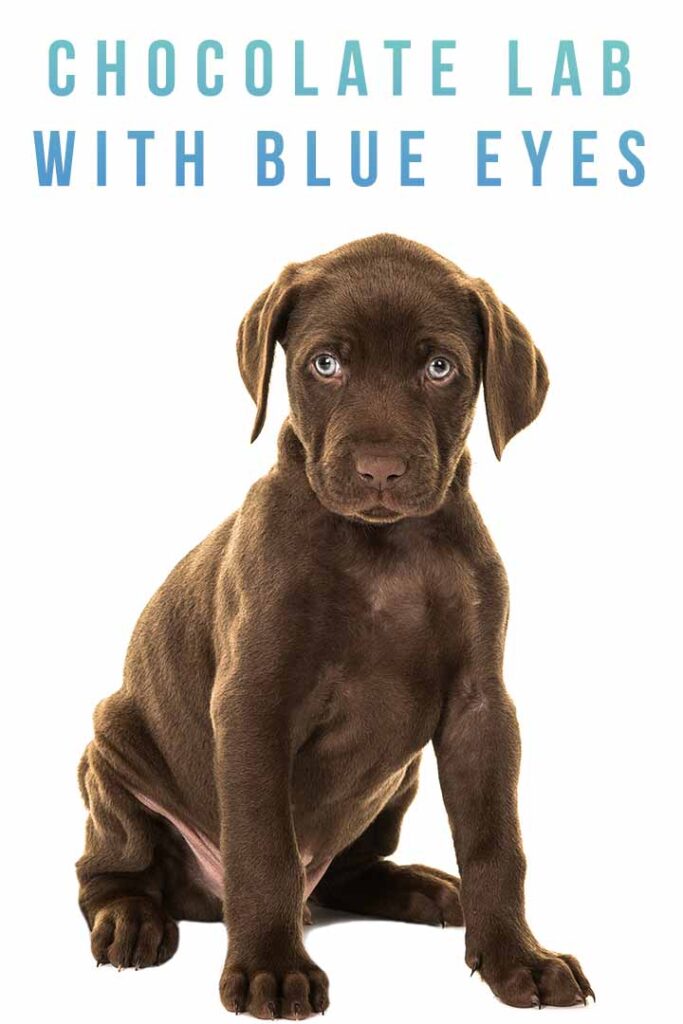Chocolate Lab With Blue Eyes for Sale Near 33165

This article is all about the beguiling possibility of a chocolate Lab with blue eyes. Do they exist? Are they common? And how much do they cost? We'll answer all these questions and more.
Every brown Lab puppy is born with blue eyes, but they inevitably turn hazel or brown by the time they're about 4 months old. In fact, there are very few ways for dogs to have blue eyes, and none of them occur naturally in the Labrador breed. But, we'll take a look at how they sometimes get added anyway.
Labrador colors
You're probably already pretty familiar with the three traditional Labrador colors: black, yellow, and brown (also known as chocolate or liver). But can you picture their eyes without looking at a photo? And since chocolate is the least common of the three colors, can you remember if you've ever seen a brown Lab with blue eyes? Probably not, but it wasn't a trick question to find out if your memory is getting rusty – in fact, a full blooded Lab with a chocolate coat can't have blue eyes.
Chocolate Lab eye color
Eye color in Labradors falls broadly into two categories: brown, and hazel. According to their breed standard, black and yellow Labs ought to have brown eyes, and chocolate Labs' eyes may be brown or hazel. Of course, a little natural variation is allowed between individuals. So brown eyes can vary from dark espresso to warm sepia, and everything in between. And hazel eyes can have varying proportions of green, amber and brown in them. At the furthest possible end of the spectrum, you might even occasionally meet a chocolate lab with green eyes.
This is true of a chocolate English Labrador belonging to show lines, and a American Chocolate brown Lab bred from working lines. But why don't Labrador eyes come in blue, and is green really the closest alternative?

Blue eyes in dogs
Did you know that blue eyes aren't actually caused by blue pigment in the eye? In fact the only pigment made in dogs' eyes is melanin, which is brown or red. When there is lots of melanin in the eye it absorbs light, and we see the color brown. When there is very little melanin, light scatters around the tissues of the iris instead, and we perceive that scattered light as being blue. Green, yellow, grey and amber eyes are caused by an intermediate amount of melanin, so that we see a mix of both phenomena.
There are four ways dogs can have so little pigment in their eyes that they appear blue, but none of them are associated with Labradors.
1. The blue eye gene
Some dogs carry a specific gene for blue eyes called ALX4, which determines the amount of pigment in the eyes independently of the genes determining coat color. Huskies are a well-known example of a breed carrying this gene.
2. Merle coloring
Merle coat coloring is closely associated with blue eyes. Dogs with the merle gene have patches of diluted pigment in their coat, and often one or two blue eyes. Common examples include Australian Shepherds and Great Danes.
3. Albinism
Albinism is a genetic condition which inhibits pigment formation anywhere in the body. Albino dogs have white fur, and blue or pink eyes. Since the medical complications of albinism are usually detrimental to dogs' welfare, breeding albino dogs is discouraged and usually avoided.
4. White spotting
The White Spotting gene series causes white patches which cover some or all of a dog's body. Dogs with white patches covering one or both eyes are also less likely to make pigment in those irises.
What about Lab with blue eyes?
Chocolate Labs don't have blue eyes because the breed standard doesn't allow for any of the genetic mechanisms which would make it possible. They are highly pigmented dogs, and that includes their eyes!
However, some Labradors with the color dilution gene do make less pigment than others. Silver Labs are chocolate Labs with the color dilution gene. Their coat is lighter brown than a traditional chocolate Lab – think more chocolate milkshake than chocolate brownie. Their eyes are lighter too – usually somewhere between amber and pale green. Silver Labs with very light green eyes are perhaps the closest it is possible to get to a chocolate Lab with blue eyes, but they still aren't blue in the truest sense.
But I've seen a chocolate Lab with blue eyes for sale!
Blue eyes don't appear in chocolate brown Labs which meet the breed standard, but you may still have seen pictures of them. Here's how.
Baby chocolate Lab with blue eyes
All Labrador puppies are born with blue eyes to begin with. Of course, you won't be able to see them right away, because they remain tight shut until they are approaching 2 weeks old. Once they open they still won't have any pigment in them yet, so puppy eyes appear blue for at least another week or two. The earliest you might start to see their final eye color appearing is about a month old, and it can take a further two months for the pigment to finish developing. So there's a good chance that you'll be able to bring home a baby chocolate Lab with blue eyes at 8 weeks old. They just won't stay blue for much longer, so enjoy them while they last!
Adult chocolate Lab dog with blue eyes
If you meet an adult chocolate Lab dog with blue eyes, the chances are they're not a full blooded Lab. They could have inherited the blue eye gene from a Husky ancestor and combined it with the genes for a brown coat. Or, they could have inherited the merle gene from a merle ancestor. If they have the merle gene they will also have a merle pattern coat, so have a look for tell tale patches of dilute fur color. But bear in mind though that merle patterning occurs on a spectrum, and 'minimal' or 'cryptic' merles have very few dilute patches at all!
If you've rescued an adult chocolate Lab with blue eyes, you can pay for DNA tests to find out what other breeds occupy places in their family tree, and whether they carry the ALX4 or merle gene.
What about a blue Labrador with blue eyes?
Finally, let's quickly talk about the possibility of a blue Lab dog with blue eyes. Blue Lab puppies are something our readers often ask about, meaning dogs with grey fur. Could this be an alternative route to a Labrador with blue eyes?
Blue dogs are black dogs with color dilution. Black Labs with the dilution gene are known as charcoal rather than blue. They are not terribly common, and their pedigree status is often subject to heated debate. Significantly for us right now though, they don't have blue eyes either.
Are chocolate Labs good dogs?
Obviously, there is more to owning a chocolate Lab than just gazing into their beautiful eyes! Whilst they have traditionally been overlooked for working roles, and even unfairly labelled as a bit unintelligent, chocolate Labs can be every bit as smart and trainable as the other Labrador colors. And they are absolutely equal for loyalty and affection. Sadly though, chocolate Labs also suffer a higher rate of ear infections and dermatitis than black and yellow Labs, and live on average one year less. For more information about the pros and cons of brown Labradors, don't miss these articles:
- Chocolate Lab – Your Guide To The Chocolate Labrador Retriever
- Chocolate Lab Vs Black Lab
- Choosing Chocolate Lab Names
Chocolate Lab with blue eyes – summary
Chocolate Lab eyes are either brown, or hazel. The closest you can get to blue, and very unusual and distinctive in their own right, is a chocolate Lab with hazel eyes that have a high proportion of green. Light brown Labrador dogs with the dilution gene (silver Labradors) may have pale green eyes too. If you choose your next pup from a litter of chocolate Lab puppies with blue eyes, enjoy their puppy looks while they last and take lots of photos to reflect on when they're grown up. Chocolate Labs aren't meant to have blue eyes forever, but that's ok – they'll still be gorgeous for their entire life!
To discover more rare Labrador colors, some with unusual eyes too, don't miss the following pages:
- Champagne Labrador – A Guide To This Controversial Coat Color
- Silver Lab – The Facts About Silver Labrador Retrievers
- Charcoal Lab: The Dilute Black Labrador Retriever
- Fox Red Lab: Your Guide To The Fox Red Labrador Retriever
- White Labradors – Discover The Beautiful White Lab
- Blue Labrador
References
Brancalion et al. Canine coat pigmentation genetics: a review. Animal Genetics. 2021.
Deane-Coe et al. Direct-to-consumer DNA testing of 6,000 dogs reveals 98.6-kb duplication associated with blue eyes and heterochromia in Siberian Huskies. PLOS One. 2018.
McGreevy et al. Labrador retrievers under primary veterinary care in the UK: demography, mortality and disorders. Canine Medicine and Genetics. 2018.

Official Standard for the Labrador Retriever. American Kennel Club. 2004.
Overall et al. Understanding the genetic basis of canine anxiety: phenotyping dogs for behavioral, neurochemical, and genetic assessment. Journal of Veterinary Behavior. 2006.
Varga et al. Being Merle: The Molecular Genetic Background of the Canine Merle Mutation. Genes. 2020.

The Labrador Site Founder

Pippa Mattinson is the best selling author of The Happy Puppy Handbook, the Labrador Handbook, Choosing The Perfect Puppy, and Total Recall.
She is also the founder of the Gundog Trust and the Dogsnet Online Training Program
Pippa's online training courses were launched in 2019 and you can find the latest course dates on the Dogsnet website
Source: https://www.thelabradorsite.com/chocolate-lab-with-blue-eyes/
0 Response to "Chocolate Lab With Blue Eyes for Sale Near 33165"
Post a Comment